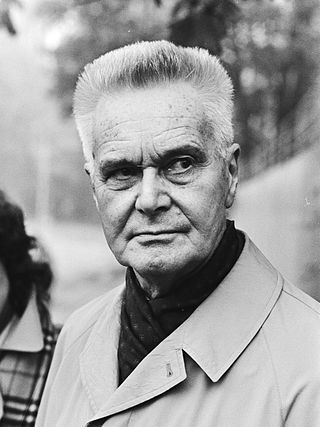
Jan Tinbergen was a Dutch economist who was awarded the first Nobel Memorial Prize in Economic Sciences in 1969, which he shared with Ragnar Frisch for having developed and applied dynamic models for the analysis of economic processes. He is widely considered to be one of the most influential economists of the 20th century and one of the founding fathers of econometrics.

Lawrence Robert Klein was an American economist. For his work in creating computer models to forecast economic trends in the field of econometrics in the Department of Economics at the University of Pennsylvania, he was awarded the Nobel Memorial Prize in Economic Sciences in 1980 specifically "for the creation of econometric models and their application to the analysis of economic fluctuations and economic policies." Due to his efforts, such models have become widespread among economists. Harvard University professor Martin Feldstein told the Wall Street Journal that Klein "was the first to create the statistical models that embodied Keynesian economics," tools still used by the Federal Reserve Bank and other central banks.
A macroeconomic model is an analytical tool designed to describe the operation of the problems of economy of a country or a region. These models are usually designed to examine the comparative statics and dynamics of aggregate quantities such as the total amount of goods and services produced, total income earned, the level of employment of productive resources, and the level of prices.
The polder model is a method of consensus decision-making, based on the Dutch version of consensus-based economic and social policymaking in the 1980s and 1990s. It gets its name from the Dutch word (polder) for tracts of land enclosed by dikes.
In social sciences, especially economics, a stylized fact is a simplified presentation of an empirical finding. Stylized facts are broad tendencies that aim to summarize the data, offering essential truths while ignoring individual details.
Articles in economics journals are usually classified according to JEL classification codes, which derive from the Journal of Economic Literature. The JEL is published quarterly by the American Economic Association (AEA) and contains survey articles and information on recently published books and dissertations. The AEA maintains EconLit, a searchable data base of citations for articles, books, reviews, dissertations, and working papers classified by JEL codes for the years from 1969. A recent addition to EconLit is indexing of economics journal articles from 1886 to 1968 parallel to the print series Index of Economic Articles.
Dynamic scoring is a forecasting technique for government revenues, expenditures, and budget deficits that incorporates predictions about the behavior of people and organizations based on changes in fiscal policy, usually tax rates. Dynamic scoring depends on models of the behavior of economic agents which predict how they would react once the tax rate or other policy change goes into effect. This means the uncertainty induced in predictions is greater to the degree that the proposed policy is unlike current policy. Unfortunately, any such model depends heavily on judgment, and there is no evidence that it is more effective or accurate.

The United States budget comprises the spending and revenues of the U.S. federal government. The budget is the financial representation of the priorities of the government, reflecting historical debates and competing economic philosophies. The government primarily spends on healthcare, retirement, and defense programs. The non-partisan Congressional Budget Office provides extensive analysis of the budget and its economic effects. CBO estimated in February 2024 that Federal debt held by the public is projected to rise from 99 percent of GDP in 2024 to 116 percent in 2034 and would continue to grow if current laws generally remained unchanged. Over that period, the growth of interest costs and mandatory spending outpaces the growth of revenues and the economy, driving up debt. Those factors persist beyond 2034, pushing federal debt higher still, to 172 percent of GDP in 2054.

The Netherlands Environmental Assessment Agency is a Dutch research institute that advises the Dutch government on environmental policy and regional planning issues. Operating as an autonomous entity within the Dutch Government organization, specifically under the Ministry of Infrastructure and Water Management. While primarily associated with the Ministry of Infrastructure and Water Management, PBL's expertise is also sought by other government departments, including the Ministry of Economic Affairs and Climate Policy, the Ministry of the Interior and Kingdom Relations, the Ministry of Agriculture, Nature and Food Quality, and the Ministry of Foreign Affairs. The research fields include sustainable development, energy and climate change, biodiversity, transport, land use, and air quality. It is one of three applied policy research institutes of the Dutch government, the other two being Centraal Planbureau (CPB), and The Netherlands Institute for Social Research (SCP). Since January 2023 Marko Hekkert is director of the Netherlands Environmental Assessment Agency.
A government budget is a projection of the government's revenues and expenditure for a particular period of time often referred to as a financial or fiscal year, which may or may not correspond with the calendar year. Government revenues mostly include taxes while expenditures consist of government spending. A government budget is prepared by the government or other political entity. In most parliamentary systems, the budget is presented to the legislature and often requires approval of the legislature. Through this budget, the government implements economic policy and realizes its program priorities. Once the budget is approved, the use of funds from individual chapters is in the hands of government ministries and other institutions. Revenues of the state budget consist mainly of taxes, customs duties, fees and other revenues. State budget expenditures cover the activities of the state, which are either given by law or the constitution. The budget in itself does not appropriate funds for government programs, hence need for additional legislative measures. The word budget comes from the Old French bougette.

Henri (Hans) Theil was a Dutch econometrician and professor at the Netherlands School of Economics in Rotterdam, known for his contributions to the field of econometrics.
Public economics(or economics of the public sector) is the study of government policy through the lens of economic efficiency and equity. Public economics builds on the theory of welfare economics and is ultimately used as a tool to improve social welfare. Welfare can be defined in terms of well-being, prosperity, and overall state of being.
An economic impact analysis (EIA) examines the effect of an event on the economy in a specified area, ranging from a single neighborhood to the entire globe. It usually measures changes in business revenue, business profits, personal wages, and/or jobs. The economic event analyzed can include implementation of a new policy or project, or may simply be the presence of a business or organization. An economic impact analysis is commonly conducted when there is public concern about the potential impacts of a proposed project or policy.

The Office for Budget Responsibility (OBR) is a non-departmental public body funded by the UK Treasury, that the UK government established to provide independent economic forecasts and independent analysis of the public finances. It was formally created in May 2010 following the general election and was placed on a statutory footing by the Budget Responsibility and National Audit Act 2011. It is one of a growing number of official independent fiscal watchdogs around the world.
The Federal Planning Bureau (FPB) is a Belgian independent public agency. It makes studies and projections on economic, social and environmental policy issues and on their integration within the context of sustainable development. The last Plan Commissioner was Philippe Donnay, assisted by Deputy Commissioner Saskia Weemaes.

Willem Hendrik Somermeyer was a Dutch economist, Professor in Econometrics at the Erasmus University Rotterdam, and member of the Royal Netherlands Academy of Arts and Sciences, particularly known for his consumption-savings model.

Coenraad Nicolaas (Coen) Teulings is a Dutch economist and distinguished professor at Utrecht University. He was formerly professor of Economics at the University of Amsterdam and the University of Cambridge and former Director of the Bureau for Economic Policy Analysis, as well as Chairman of Merifin Capital.

Wim Driehuis is a Dutch economist, Emeritus Professor Economics and Business at the University of Amsterdam.

Paul Johannes George Tang is a Dutch politician who has been serving as a Member of the European Parliament (MEP) since 2014. He is a member of the Labour Party, part of the Progressive Alliance of Socialists and Democrats. Between 2007 and 2010 Tang was member of the House of Representatives of the Netherlands.

The Netherlands Institute for Social Research is a Dutch interdepartmental scientific institute that carries out solicited and unsolicited social scientific research. The SCP reports to the government, the Senate and House of Representatives, the ministries and social and government organisations. The SCP is formally part of the Ministry of Health, Welfare and Sport. The SCP was established by Royal Decree on March 30, 1973. The Netherlands has two planning offices. The oldest is the Bureau for Economic Policy Analysis (CPB), which is mainly concerned with economic development. The Netherlands Environmental Assessment Agency focuses primarily on spatial planning and the sustainability and quality of the living environment.










